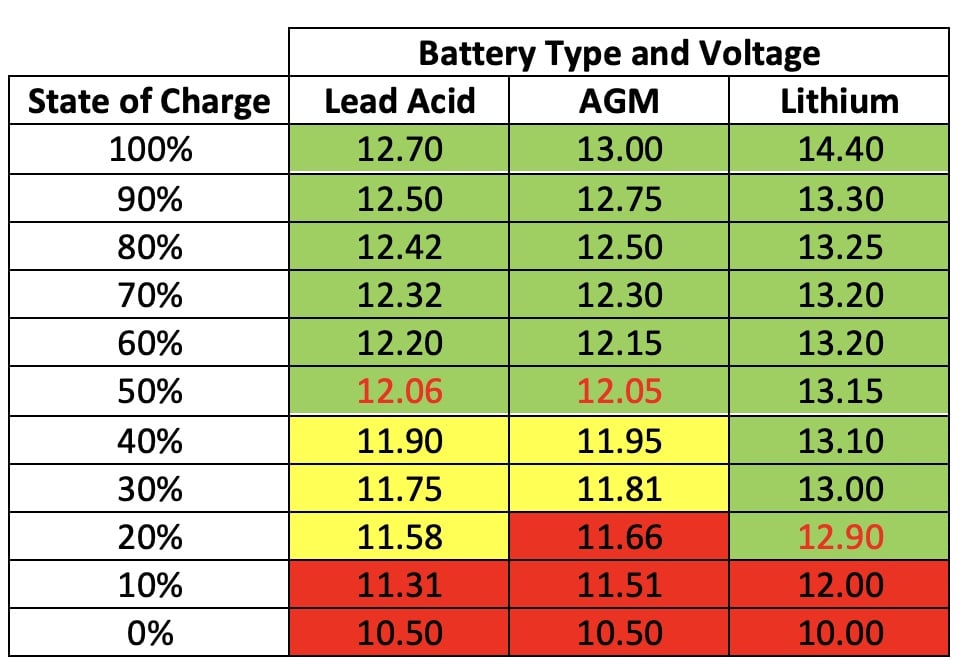
Running 12V camping accessories in your 4×4 can take your camping experience to the next level. Simple accessories such as a fridge and lighting can make all the difference.
Contents
- Auxiliary Batteries
- How to Recharge your Auxiliary Battery
- Types of Batteries
- Starter Batteries
- Deep Cycle Batteries
- Lead Acid
- Gel/AGM
- Lithium
The Problem
If you connect directly to Starter Battery – The most simple (and least ideal) – connect the accessories to your main battery; either directly or via the cigarette lighter socket etc in your car.
These accessories can only safely run while the engine is running, once the engine is off-you should disconnect/switch off all the accessories; because they will start to drain your main battery-then your vehicle may not be able to start.
The solution to this problem is to get a secondary (or auxiliary battery), that is separate from the main battery; so that even when this battery it is drained the vehicle can still start.
Get an Auxiliary Battery
- Permanently Mounted – this can be mounted either under the bonnet (if there is space), or somewhere inside the vehicle.
- Mobile Battery/Power Pack – there are mobile battery boxes available that can be moved
How to recharge your Auxiliary Battery?
Once you have an auxiliary battery; you will need a way to recharge it. The easiest way is to connect the auxiliary battery to your vehicle main battery (so when the engine is on, the alternator will happily charge both batteries). However; the problem comes in when the engine is turned off; you need a way to disconnect your main battery from the Auxiliary battery (otherwise it may get drained by the auxiliary battery and 12V accessories).
There are two ways to do this:
1. Dual Battery Isolator
Dual Battery Isolator is simply a switch; that will disconnect your main battery from your auxiliary battery when the engine is off. There are two types:
- Manual Isolator – as the name suggests; is a manual switch. That you must turn when the engine is off.
- Smart Battery Isolator – this is an automatic isolator that uses the output from your vehicles alternator to detect when the engine is running or not. However these will not work for Smart Alternators or Temperature compensating alternators (many vehicles after 2000 came with these types of alternators).
An isolator is the cheapest solution, it simply gives out whatever charge is coming from the alternator (and this is shared between the starter battery and the auxiliary battery).
Examples of this kind of system are:
- National Luna 12V Split Charger
- Tmax Dual Battery Isolator
2. DC/DC Charger
A DC/DC Charger combines the function of an isolator with a multi stage battery charger. It provides your auxiliary battery with the correct charging voltage (for the type of battery). This charger also measures the battery temperature and will adjust the current to maintain optimum conditions. Many DC/DC chargers can also accept solar input. This is the best kind of system because it will maximise the life of your auxiliary battery by charging it correctly (the isolator type systems won’t be able to bring your auxiliary battery back to full charge as they focus on charging the main battery-resulting in a deterioration in auxiliary battery life over time).
Types of Batteries
Starter Batteries – these are designed to give short bursts of high current (i.e. to start your car between 100-300Amps). These batteries are not designed to be used for long periods of time (without being charged). Once they drop to 75% of their capacity the life of the battery dramatically reduces (usually these batteries can only sustain 30-150 deep cycles). This means for a 100Ah starter battery you can only use 25Ah before it becomes a deep cycle and you start killing the overall life of the battery. These batteries are designed to be discharged by 2-5% of their overall charge during normal operation (and they can sustain thousands of cycles of this). The advantage of these batteries are that they charge much faster (than deep cycle batteries).
Deep cycle batteries – these batteries are designed to provide low current for a long period of time. These batteries can go down to 20% of their capacity before their battery life is compromised. This means for the same 100Ah battery you can use about 80Ah before the life of the battery gets compromised. Although for maximum life it is recommended to use these batteries down to 50% of their charge. These batteries take a lot longer to charge themselves up (up to 24 hours to reach 100%)
Both types of batteries will work as an auxiliary battery. The starter battery won’t last as long, but it does have some advantages:
- Faster recharge rate
- Cheaper
- Lighter
The disadvantages of the starter battery are:
- Shorter life span (30 to 150 deep cycles).
- They heat up when charged.
Lead Acid – this is the most basic and pocket friendly option. They are suitable for mounting in the engine bay. However they tend to suffer severely from shortened life if not fully discharged and recharged each use.
Gel/AGM – most of these are not recommended to be stored in the engine bay (as they do not work well in high temperatures). They can be discharged more than Lead Acid batteries without affecting their life (i.e. they have a larger usable range – up to 50% of their total capacity). (these types of batteries require precise chargers and will not work well with a battery isolator).
Lithium – these cannot be stored in the engine bay as they are affected by heat. They have the lowest weight and highest usable capacity of the three. They can actually be discharged down to 20% (that means you can use up to 80% of the battery capacity). They can handle a higher charging current. They also recharge much faster (because they can be fed with a high charging current) than the other battery types. Lithium are by far the most superior option; but also the most expensive.


The above table shows the discharge voltages of the different types of batteries. It is critical to keep this voltage in mind when using the respective batteries. You should not discharge below 50% for Lead Acid or AGM batteries (therefore only discharge until 12.06V and 12.05V respectively for those batteries). Any further discharge will permanently reduce the battery life.
Since Lithium batteries can go down to 20% without being permanently damaged; you can safely discharge a Lithium battery down to 12.9V.

